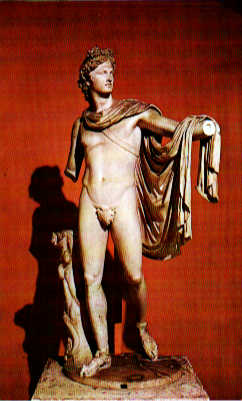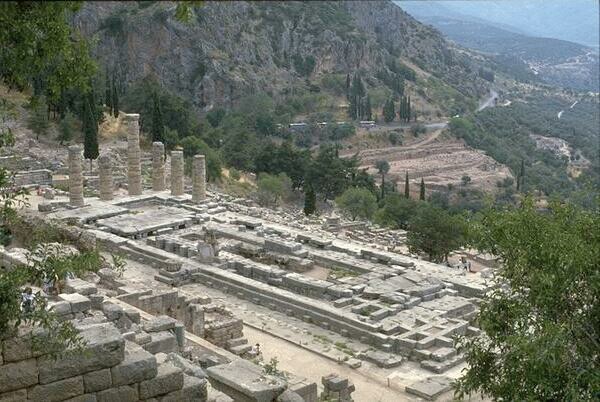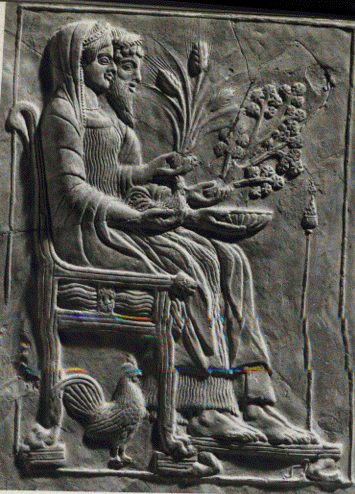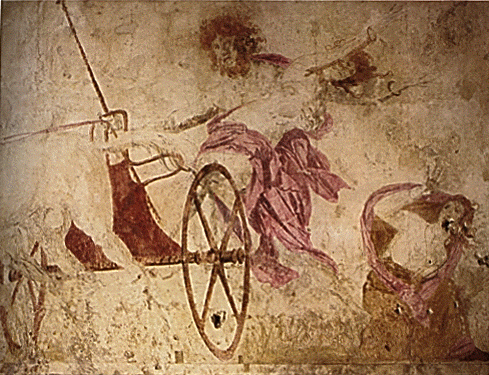 |
GREEK VIEWS ON DEATH(PART I) |
|||
APOLLO AND DEATH
(A) APOLLO HYAKINTHIOS
: a cult dedicated to Apollo in Laconia (Sparta). The shrine was at Amyclae, some 5 miles south of Sparta town. The shrine is described in Pausanias' Description of Greece (II cent. A.D.) Book III. The explanation of the cult name is given in the story of the handsome young Spartan Prince HYAKINTHOS, with whom Apollo fell in love. See: Ovid Metamorphoses X. 162-219; Apollodorus I. 1.1-2; Pausanias IV. 19.It seems, in fact, that Hyakinthos was the first young man in history with whom another male (the Poet THAMYRAS) fell in love. Thamyras boasted that he could surpass the Muses in song (cf. Athena and Arachne and weaving, Apollo and Marsyas the Satyr in singing). Apollo jealously told the Muses, who robbed Thamyras of his sight, voice, and memory for lyre playing. (See: Homer Iliad II. 594-600; Apollodorus Bibliotheka I. 3.3; Pausanias Guide to Greece IV. 33.3-7)
The WEST WIND (Zephyros) too fell in love with HYAKINTHOS, and one fine day when Apollo was teaching his boyfriend how to throw the discus (a sort of ancient frisbee made out of stone or metal), the Wind blew it off course so that it hit Hyakinthos in the head and killed him. From the boy's blood that fell on the ground sprang the hyacinth flower, which has on its petals the initials of Hyakinthos. [Note that -inthos is actually a pre-Greek place-name ending, as in Corinth, Probalinthos, etc.]

The Death of Hyakinthos,
by Jean Broc (Musée de Poitiers)
The month Hyakinthos is found in the calendars of Sparta, Gytheion, Thera, Rhodes, Kos, Knidos, Kalymna, and maybe Byzantium. Despite Robert Graves' statement in the Greek Myths I, p. 81, the order of the month in the calendars and the season at which it fell is, to a large extent, unknown. [See: Alan E. Samuel, Greek and Roman Chronology (München 1972) p. 93.]
(B) APOLLO AND HIS SON ASKLEPIOS
: APOLLO was in love with CORONIS (`crow'), the daughter of King Phlegyas of the Lapiths (a son of Zeus, brother of Ixion, temple burner)Coronis was unfaithful to Apollo with ISCHYS the Arcadian (!) while she was pregnant with Apollo's child. A white bird, set by Apollo to keep watch over Coronis, informed the god about the infidelity, and (in anger) Apollo complained to Artemis his sister, who used her bow and arrows on the unlucky girl. Too late, when she was already being cremated, Apollo repented of his anger. He had his brother HERMES (PSYCHOPOMPOS) cut the child, still alive, from the womb of the deceased Coronis. The child ASKLEPIOS was carried off by Apollo and placed in the Hero Academy which was run by the Centaur CHEIRON. Apollo shot down Ischys, and turned the white bird to coal black (it became a crow or raven: etymological explanation) because it had not kept Ischys away from Coronis.When Asklepios grew up he practiced the art of medicine (which he learned from Apollo and Chiron). Athena gave him two vials of Medusa's blood; the one could kill instantly, the other could raise the dead. Asklepius used this latter fluid on Tyndareus, Capaneus, Lycurgus and Hippolytus, much to the annoyance of great-uncle Hades, who complained to Asklepios' granddad Zeus that his privileges were being violated. Zeus killed his grandson with a thunderbolt, but later was compelled to bring him back to life because of his knowledge of medicine which would work for divinities. (Cf. twice-born Dionysos)
The most famous sanctuary of Asklepios was at Epidauros in the Peloponnesus. There is an excellent
presentation of the site and the texts associated with Asklepios at the Virtual Epidauros site at Miami
University of Ohio.
(C) Apollo and MARSYAS:
boasting and contest motif.(D) APOLLO SMINTHEUS: ('The Mouse God')
Apollo is both a patron of healing and a god of plague: Homer Iliad Book I, beginning. Sophocles Oedipus Tyrannos, Prologue. It is Apollo who takes the initiative in the death of Achilles. | |||||
The Temple of Apollo at Delphi | |||||
 |
~HADES~ |  | |||
HADES: one of the Twelve Olympians, brother of Zeus and Poseidon.
(1) RAPE OF PERSEPHONE:
with Zeus' connivance, Demeter's daughter taken to Underworld. Explains cycle of the seasons. Pomegranate. (Homeric Hymn to Demeter: Powell, Classical Myth, pp. 229-241.)
(2) Hades is sometimes called Zeus Katachthonios (`Underworld Zeus').
He is also known as Aidoneus and PLOUTON (`The Rich')–itles used to avoid mentioning his real name–
as well as Polydegmon (`Hospitable') and Eubouleus (`He of Wise Counsel'). Persephone is also called
Eubouleia, especially in the Orphic lamellae: Powell, Classical Myth, fifth edition, pp. 313-316.
(3) Hades has no shrines or temples of his own, except in Elis (w. Peloponnesus), and the small temple in the
Sacred Enclosure at Eleusis.
(4) Hades rarely leaves the `House of Hades' in his golden chariot drawn by four black horses.
Once he did go after the nymph MENTHE, but Persephone turned her into a shrub (`mint'). He also hit on
the nymph LEUKE (`white') who became a white poplar tree.
(5) Hades is not the Devil, and does not usually punish souls in the House of Hades. Punishments take place in Tartaros.